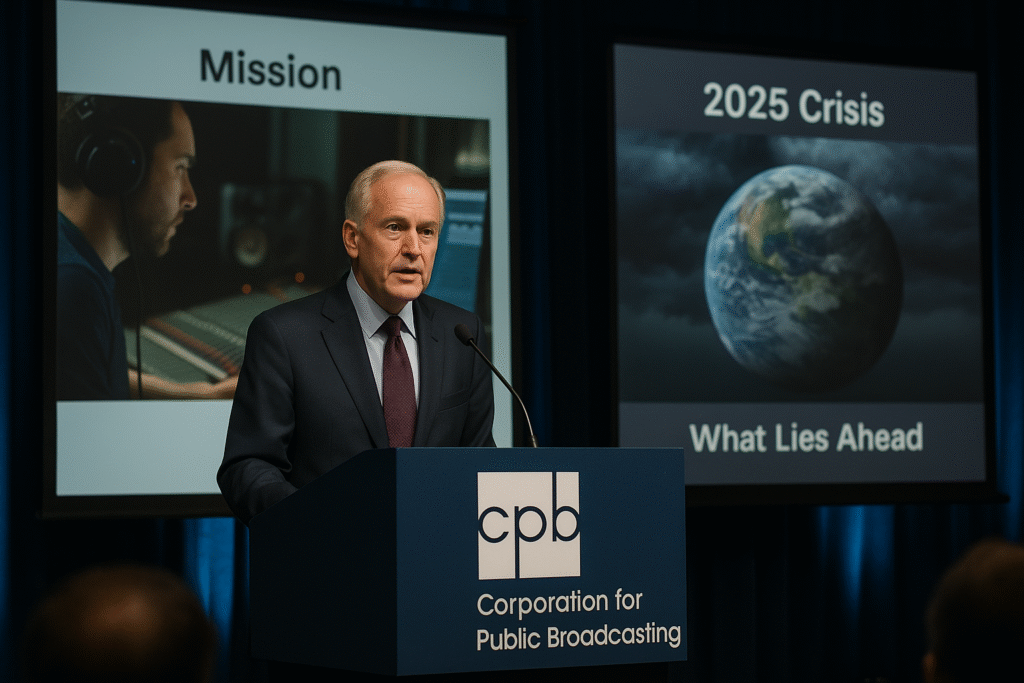
The Corporation for Public Broadcasting, called CPB, was set up in 1967 to distribute federal funding for academic radio and television with the aid of Congress. In this capacity, as a private, non-profit enterprise, CPB performed an imperative function in helping Public Broadcasting Services (PBS), National Public Radio (NPR), and in addition, a few 1,500 neighbourhood public media stations across the USA..
Origin and Mission
The Public Broadcasting Act of 1967 created the CPB as an independent unit to encourage diverse, non-commercial programming provided by commercial media. The CPB distributes more than 70% of its annual federal funds directly to local stations, with a 5% statutory cap on its operating expenses. CPB’s missions include long-standing underserved communities, emergency alerts, educational materials, and support for culturally rich programmes.
2025 Budget: Federal Support and Its Impact
In the financial year 2025, CPB received an appropriation of $535 million from Congress, as well as $10 million in interest revenue, totalling $545 million. The same year, we funded approximately $267.883.396.8 million in direct grants for public television stations; furthermore, it allocated $83.3 million for public radio. Additionally, CPB allocated $96.8 million for television programming and $28.6 million for national radio program production and acquisition, system operations, and adequate support for station services.
Despite increasing public media stations receiving much more funding than private donors, CPB funding made up about 10–15% of local TV station revenue and about 6% of public radio budgets, which is especially important in rural and lower-income areas.
Political Change and Executive Orders in 2025
On May 1, 2025, the US president signed Executive Order 14290, directing CPB to close all funding for NPR and PBS by June 30, 2025. The order cited concerns over media taxpayer subsidies to take prejudice. Consequently, the CPB leadership objected, and asked for the executive control of his charter grant freedom, while also promising to carry forward legal action.
In addition, Congress passed the 2025 Rescue Act, which included funding CPB $1.1 billion in two years. Specifically, the House voted in June 2025, whereas the Senate finalized zero funding for CPB in the future budget years in July.
CPB Shutdown Begins
By August 1, 2025, CPB confirmed that this funding would stop operations due to cuts. The company will close most of its employees, for more than 100 employees, by September 30, 2025, and a small transition team will continue till January 2026 with music rights, grant contracts, and station coordination to handle the finished functions.
The Chairman of the CPB emphasised the difficult reality: the operation should end despite comprehensive public resentment, petitions, and appeals from public media leaders.
Results for Local Public Media
The shutdown will greatly affect 1,500 public radio and TV stations. Many local allies rely on CPB for emergency alert infrastructure, educational programming, and rights coordination. With the loss of federal funding, stations in rural and lower areas have to face a lack of budget. For example:
- A public broadcasting station in Atlanta lost more than 13% of its budget and raised emergency donations to operate simultaneously.
- In Pittsburgh, the local PBS station shut down 19 employees, as the revenue fell due to losing the CPB grant, which represented about 13% of its budget.
They are now scratching stations to change federal funds through donations, foundation grants, and cost cuts. Some media experts argue that this pressure may increase more and more local freedom or close the station.
Legal and Legislative Competition
The PBS and NPR leadership have filed the cases challenging the executive order and the Rescue Act, in which the steps violate the CPB’s congressional charter and reduce First Amendment security. Meanwhile, CPB continued legal efforts against efforts to dismiss the members of the board, keeping them free.
Public media advocates that CPB funding is only a small part of the federal budget and provides high value, especially for taxpayers who are given returns on their dollars when local donors match about seven times from public investment.
CPB Heritage and Major Contribution
In nearly six decades, CPB supported:
- Educational TV and Radio, plus universally accessible materials
- The American Archive of Public Broadcasting, preserving thousands of historical broadcasts
- An important emergency communication system for rural audiences
- Material and infrastructure not covered by market-driven media.
The CPB’s board had long ensured bipartisan oversight, in which the members of the board were appointed by the presidents of various parties to support fairness.
What comes next?
With the CPB being cut, NPR and PBS should rely almost completely on non-union sources. Local stations face budget models, which require more heavy lifting: more frequent fund drives, corporate underwriting, and potential consolidation.
Other analysts predicted a patchwork future: large stations can survive through personal support, while small local outlets in remote areas may be closed, especially to reduce the increase in information deserts during emergency conditions.
Final thoughts
The Corporation for Public Broadcasting has served the US since 1967 as a federal steward of public media, giving fuel to dozens of educational, civilian, and emergency services across the country. Nevertheless, in 2025, political decisions ended their funding, which led to the complete collapse of its operation.
As the CPB closes its doors, the U.S. The future of public radio and television enters an important phase. Local stations, national networks, and advocacy groups now face the challenge of maintaining a public media legacy outside federal support. Do millions of Americans lose access to reliable journalism, educational materials, and important alerts, or do new funding models emerge to fill the void? Only time will tell.

